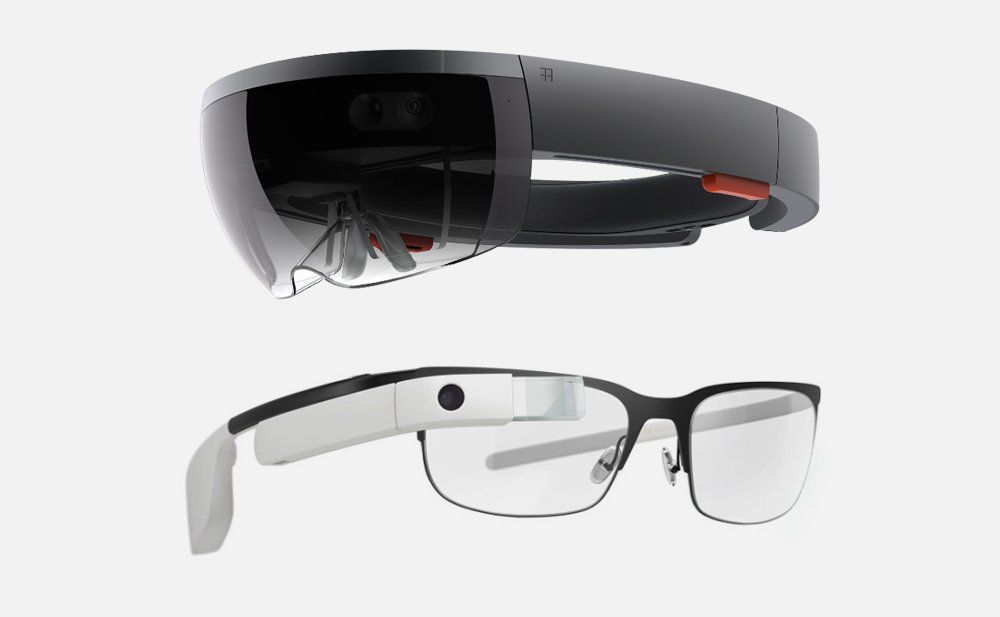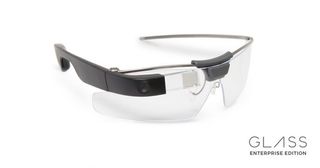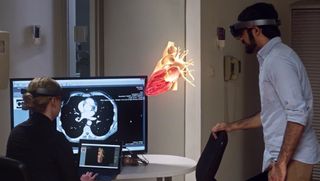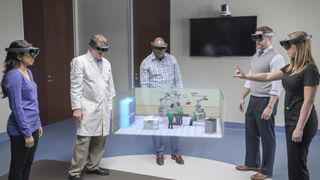Google Glass and HoloLens clash in the enterprise en route to consumers
Computers are coming up on a revolution. Microsoft's HoloLens and Google's Glass aim to make augmented reality (AR) mainstream. But to reach consumers, they're going through the enterprise.

Changing a paradigm isn't easy. The inertia of the "usual way of doing things" can be very difficult to alter. This is particularly evident when you consider human behavior and the neurological, emotional, psychological and social aspects that contribute to habit formation and entrenched behavior. Couple these intangible internal human variables with technological challenges, limitations, costs and practical applications of new technology and it becomes abundantly clear why change is hard.
The concept of personal computing conjures images of someone sitting at a desk dutifully pecking away at a keyboard with eyes affixed to a screen. That vision began to undergo a metamorphosis within the last ten years, after the advent of the consumer-focused smartphone market. The mobility of smartphones combined with ever-increasing processing power and a virtual "swiss army knife" of apps has made personal computing an "anywhere" experience for "anybody" regardless of age or demographic.

The ideology of ever-present computing that has settled to the backdrop of our "new normal" has laid the groundwork for an eventual acceptance of a move of our "personal computers" from our pockets to our faces.
Heads up
Intermittent peeking at our digital world's via our smartphones has already transitioned to persistent peering at them during virtually any free (or not so free) moment. This has created a demand for smartphone etiquette, anti-texting while driving laws, a diminishing of social interactions and an appeal for people to raise their heads from their screens to interact with the people and world around them.

The coalescing of these factors are moving us toward a point where the increasingly persistent peering at our phones may be replaced with a perpetual and simultaneous viewing of a merger of our digital and physical worlds via AR smartglasses or headsets.
The consumer space isn't quite ready technologically, fiscally or socially for that shift, but the business world may be prepared to dive in head first.
Glass act
In 2012 Google introduced its slim AR headset Google Glass. The ambitious attempt to bring AR to consumers didn't meet with success, however. At $1500 the cost was prohibitive for many buyers, particularly since its limited use cases couldn't justify such an investment.
Get the Windows Central Newsletter
All the latest news, reviews, and guides for Windows and Xbox diehards.

Concerns about privacy were also a barrier. The camera on Google Glass naturally led to uneasiness around surreptitious recording. Poor battery life, an aesthetically unappealing design, worries about constant exposure to radiation, no clear purpose and poor marketing also contributed to Google's shattered consumer Glass dreams.
Still, that wasn't the end of the story. For the past few years Google has continued investing in Glass and has recently divulged its enterprise focused progress and vision
Glass repair: Glass Enterprise Edition

Google Glass Enterprise Edition is a manifestation of Google's regrouping and applying its AR vision where the company felt it could succeed. For the past two years Google has worked with 30 expert partners building customized software and business solutions for Glass.
These efforts have resulted in Google forging partnerships with 50 companies such as GE, AGCO, Dignity, DHL, Volkswagon and others that have incorporated Glass within their business.
Google boasts that replacing physical manuals with text or videos viewed through Glass has increased worker's efficiency.

Glass, unlike HoloLens, is streamlined and can be attached to a regular pair of glasses or goggles. It projects information in a portion of a wearers field of view via a single display over the right eye. It does not provide the "immersive" experience the HoloLens creates via its displays in front of each eye.
Glass is also smartphone-dependent. Unlike HoloLens, it is more a smartphone accessory or peripheral, than a fully independent, self-contained computer. The less advanced Glass is likely much cheaper to make than the $3000 developer edition and $5000 enterprise editions of HoloLens.
Google has opened its enterprise Glass program to more businesses in hopes of forging additional partnerships.
HoloLens: Starting on the right foot
Microsoft, to the dismay of many fans who desperately want a HoloLens began its AR strategy by building partnerships and tailored solutions in the enterprise. Redmond accurately gauged the "lack of readiness" of the consumer space, and by skipping consumers (for the time being) avoided the disaster that befell Google with its first Glass attempt. Timing is everything.

For now, Microsoft is content to maintain its enterprise focus. The company boasts partners like NASA, the US military, the health care industry, the entertainment industry, the education sector and more.
Microsoft recently announced that the second version of HoloLens will have an AI coprocessor incorporated in the Holographic Processing Unit (HPU). The HPU is what enables the HoloLens to be the world's only fully self-contained holographic computer. This new AI coprocessor will enable the HoloLens to natively and flexibly implement deep neural networks (DNN).
The implementation of native DNN will allow the HoloLens to efficiently process the complex and enormous amounts of data that are received from the headset's range of sensors. The HoloLens, as a full Windows 10 computer, is a far more complex AR device than Google Glass. It's not dependent on any other device and is open to developers to create a range of applications that operate directly from the apparatus.
As a Windows 10 PC, users can execute familiar PC tasks on HoloLens as easily as they do enterprise-tailored AR solutions. It's a comprehensive device.
From the enterprise to the consumer
Personal computers in the workplace were critical to familiarizing users with PCs at the dawn of the personal computing era. In time use cases for Windows and productivity tools like Office began emerging for home-based scenarios. The cost and relevance challenges began falling in the face of greater consumer demand for PCs and the accompanying software. Ultimately as personal computing began to trickle, then flow to the consumer space, PC costs dropped resulting in a robust personal computing environment.

History may later reveal that smartphones and the mobile computing paradigm they introduced are a mere transitory phase to holographic or AR computing via wearables and not the mobile end game some perceive smartphones to be. To see that path one must take a long view and consider the shifts that are currently underway and not just the smartphone that is in their pockets.
During the early days of computers, there were naysayers who mocked the idea of a computer in the home. They were short-sighted. As holographic/AR computing becomes prevalent in the workplace, consumers will be made more familiar with it, and like PCs, relevance for home use may increase, and as it trickles into the consumer space costs will drop and applications for AR computing in the home will increase. Like PCs, wearable computers may become commonplace.
A PC on every face?
Microsoft's early goal was a PC on every desk and in every home. Its new goal may be a PC on every face.

The difference in this scenario is Microsoft does not have a virtual monopoly as it did with Windows, Office and the PC space. The enterprise space has two powerful companies courting it to accept two very different AR solutions. One, a full Windows 10 wearable PC, the other a light-weight Android-based wearable smartphone peripheral. We're still in the very early days of AR, and the likes of Apple, Magic Leap, and others may soon get involved.
Microsoft's advantage is that most corporate IT infrastructures run on Windows. If Microsoft leverages that position and offers HoloLens as part of the broader IT solution, it may have an edge.
AR is coming to the masses via wearable tech. Increasingly consumers will use it at work. The question is will it be Windows or Android-based? Or will Apple's ARKit be the wildcard? If Microsoft wins in the AR space, it could be the company's key back to OS dominance. Especially if Microsoft's ultimate mobile device or "Surface phone" vision ultimately is not a pocketable device at all, but is a pair of Windows 10 AR glasses with telephony.
Jason L Ward is a columnist at Windows Central. He provides unique big picture analysis of the complex world of Microsoft. Jason takes the small clues and gives you an insightful big picture perspective through storytelling that you won't find *anywhere* else. Seriously, this dude thinks outside the box. Follow him on Twitter at @JLTechWord. He's doing the "write" thing!
